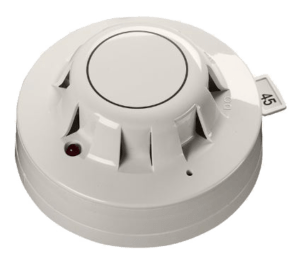The S21 Ion Sensor offers faster response times for hot burning fires
Ion Sensor

Distributed Architecture
Highly Survivable
The S21 Ion sensor’s drift compensation is managed by the ALM3-IP. The ALM3-IP monitors the average ambient analog count being returned from each S21 detector connected to the system. Due to the accumulation of dirt and dust over time, the average ambient analog count for each detector will climb. The ALM3-IP will adjust the specific detector’s alarm threshold proportionately to compensate for the rise in the average ambient count. This keeps the detectors sensing window open to the factory set tolerances established when new.
- DET2102 – S21 Ionization Smoke Detector
- Sleek, non-fading white polycarbonate enclosure
- Zero insertion force base
- Drift compensation to keep sensing window open and nuisance alarms eliminated
- Patented programming card eliminates addressing errors during system installation and maintenance
- Alarm flag sends signal to system even when device is not being interrogated
- Wide variety of addressable input/output devices
- Relay and synchronized temporal sounder bases
- Line isolators and isolator bases also available
- RoHS Compliant
The contractor shall furnish and install, where indicated on the plans, addressable ionization smoke detectors with one of the several addressable mounting base options available. The detector base will contain the patented programming card which will permit the free interchange of sensor heads without requiring additional programming of the detector head or attached base. The intelligent detector shall be capable of generating an alarm flag and report its address when the pre-set UL/ULC thresholds are exceeded. The detector shall flash its LED intermittently when polled and shall latch when the unit goes into Alarm. The detector shall be capable of reporting its average ambient analog count to the fire control network in order to facilitate drift compensation adjustments necessitated by the accumulation of dirt over time in order to keep the detector sensing evaluation window at factory set tolerances in accordance with UL allowances. The combination of the detector head and twist lock mounting base shall be UL/ULC listed and UL/ULC listed as compatible with Harding network fire controls. The detector base shall be installed without regard to wire polarity. The ionization detector shall be the Harding part number DET2102.
- Ion
-
The S21 Ion sensor’s drift compensation is managed by the ALM3-IP. The ALM3-IP monitors the average ambient analog count being returned from each S21 detector connected to the system. Due to the accumulation of dirt and dust over time, the average ambient analog count for each detector will climb. The ALM3-IP will adjust the specific detector’s alarm threshold proportionately to compensate for the rise in the average ambient count. This keeps the detectors sensing window open to the factory set tolerances established when new.
- DET2102 – S21 Ionization Smoke Detector
- Data Sheet
- Specs
-
- Sleek, non-fading white polycarbonate enclosure
- Zero insertion force base
- Drift compensation to keep sensing window open and nuisance alarms eliminated
- Patented programming card eliminates addressing errors during system installation and maintenance
- Alarm flag sends signal to system even when device is not being interrogated
- Wide variety of addressable input/output devices
- Relay and synchronized temporal sounder bases
- Line isolators and isolator bases also available
- RoHS Compliant
- Architects
-
The contractor shall furnish and install, where indicated on the plans, addressable ionization smoke detectors with one of the several addressable mounting base options available. The detector base will contain the patented programming card which will permit the free interchange of sensor heads without requiring additional programming of the detector head or attached base. The intelligent detector shall be capable of generating an alarm flag and report its address when the pre-set UL/ULC thresholds are exceeded. The detector shall flash its LED intermittently when polled and shall latch when the unit goes into Alarm. The detector shall be capable of reporting its average ambient analog count to the fire control network in order to facilitate drift compensation adjustments necessitated by the accumulation of dirt over time in order to keep the detector sensing evaluation window at factory set tolerances in accordance with UL allowances. The combination of the detector head and twist lock mounting base shall be UL/ULC listed and UL/ULC listed as compatible with Harding network fire controls. The detector base shall be installed without regard to wire polarity. The ionization detector shall be the Harding part number DET2102.
